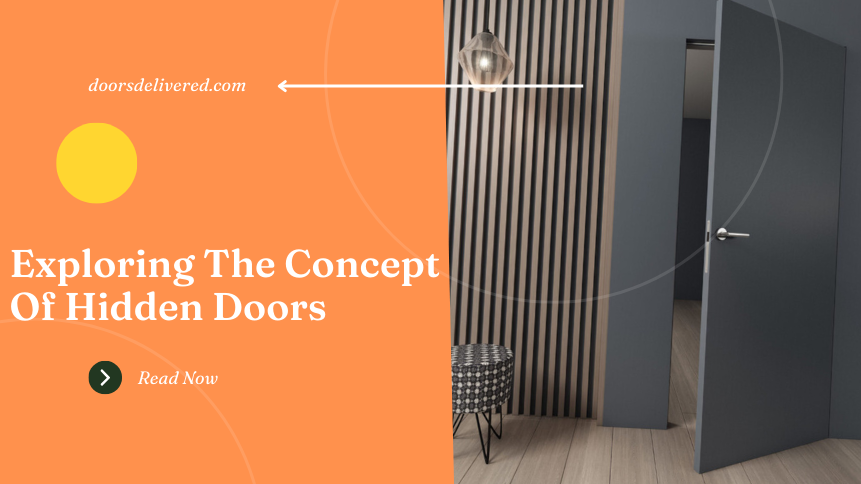WHAT?
Concealed doors, also known as secret or hidden doors, represent a door system that deviates from traditional designs by forgoing door jambs or architraves. Leveraging advancements in modern production technology, steel can now be cold-rolled into intricate shapes, enabling the creation of steel door frames with a flush ‘edge’ that seamlessly integrates with the wall, eliminating the need for visible jambs and architraves. The advent of invisible hinges, increasingly utilised over the past 15 years, ensures that the hinges remain hidden from view. The final outcome is a door that lies flush and level with the wall, offering the option to virtually ‘disappear’ or remain discreet by aligning its design with that of the surrounding wall.
Achieving this seamless integration necessitates precise alignment, with small, uniform gaps maintained between the door and the wall on all sides. Thus, the hinges must be adjustable in three dimensions—up/down, left/right, in/out—to ensure a flawless finish. If seeking a concealed door system, it is advisable to opt for hinges with these adjustable features.
WHY?
The adoption of concealed doors is primarily driven by design considerations, and several factors contribute to their increasing popularity. Firstly, they complement contemporary interior designs by eliminating architraves, resulting in smooth lines of sight along walls and across doors without the visual interruptions of traditional trim.
The terms secret and hidden evoke a sense of mystery, suggesting something meant to be concealed. However, in the realm of interior design, the practicality of concealed doors becomes evident. Historically, finding the right door design to harmonise with interior aesthetics has been a challenge for designers, influenced by individual taste and the limited availability of suitable designs.
Concealed doors offer a solution by seamlessly integrating into the overall interior design. Painting the door the same colour as the walls or applying matching wallpaper transforms the door into an inconspicuous element of the design, eliminating its visual prominence. Taking this concept further, one can enhance the design by incorporating specific wall pictures or patterns onto the door, expanding creative possibilities akin to adding an extra canvas to a painting.
Concealed doors not only serve functional purposes but also extend the potential for innovative and cohesive interior design.
FAQs
What are concealed doors, and how do they differ from traditional doors?
Concealed doors, also known as secret or hidden doors, deviate from traditional designs by eliminating door jambs or architraves. They seamlessly integrate into the wall, creating a flush and level surface. This design departure is achieved through the use of steel door frames, invisible hinges, and advanced production technologies.
What makes concealed doors “adjustable,” and why is it important?
Concealed doors are often equipped with adjustable hinges in three dimensions—up/down, left/right, in/out. This adjustability ensures precise alignment between the door and the wall, maintaining uniform gaps on all sides. This feature is crucial for achieving a flawless and seamless integration with the surrounding wall.
Why are concealed doors gaining popularity in interior design?
Concealed doors complement contemporary interior designs by eliminating architraves, providing smooth lines of sight along walls. The minimalist and modern appearance, coupled with the ability to customise the door to match the wall’s colour or design, makes concealed doors increasingly popular among those seeking a sleek and cohesive aesthetic.
Are concealed doors purely for aesthetic purposes, or do they offer functional benefits?
While concealed doors certainly enhance the visual appeal of interior spaces, they also offer practical benefits. The absence of protruding door jambs allows for efficient space utilization, making them suitable for smaller rooms. Additionally, concealed doors can be used to create hidden storage areas, concealed entrances, or integrated into multi-functional furniture.
Can concealed doors be customised to match specific themes or designs?
Yes, concealed doors offer extensive customisation options. They can be painted to match the wall’s colour or adorned with unique patterns and designs, making them a versatile canvas for creative expression. This customisation allows homeowners and designers to tailor the doors to specific themes within a space.
Do concealed doors require special maintenance or care?
Concealed doors typically do not require more maintenance than traditional doors. Regular cleaning and occasional checks on hinge adjustments are advisable to ensure they continue to function seamlessly. Specific care instructions may vary based on the materials used in the door construction.
Can concealed doors be used in any type of space or architectural style?
Concealed doors are versatile and can be incorporated into various spaces and architectural styles. Whether in modern, minimalist, or traditional settings, concealed doors adapt well to different environments, adding a touch of sophistication and functionality.
Where can I find concealed door options for my home or project?
Concealed doors are available through various suppliers and manufacturers specialising in innovative door solutions. Local home improvement stores, as well as specialised door and hardware retailers, may offer a range of concealed door options. Additionally, consulting with an interior designer or architect can provide guidance on incorporating concealed doors into your specific project.
